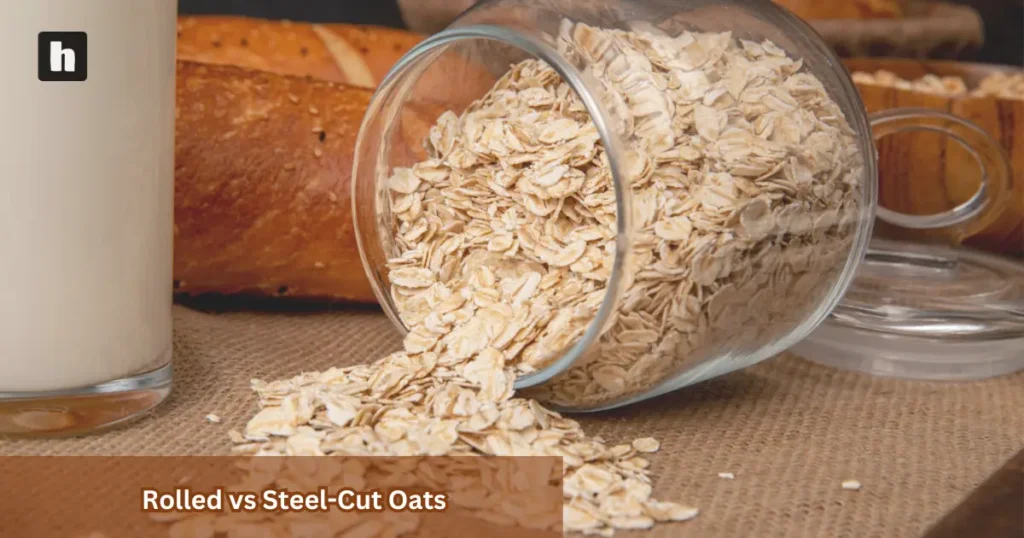
A warm bowl of oats may be the first thing that comes to mind when considering a filling, healthy breakfast. They are not only versatile but also rich in essential nutrients. There are different varieties to choose from, such as steel-cut oats and rolled oats, which have different processing techniques and nutrient profiles.
The main differences between each of these are explained in this article, so you can choose the one that best suits your lifestyle.
What are rolled vs steel-cut oats?
Rolled oats
The process of making rolled oats, also known as old-fashioned oats, involves steaming oat groats and rolling them between steel rollers to give them a flat surface. A common use for rolled oats is porridge, granola, or oatmeal cookies.
Steel-cut oats
The original, raw oat groat is most closely linked to steel-cut oats. Compared to rolled oats, steel-cut oats have a nuttier flavor and a coarser, chewier texture. They also require more time to prepare, requiring 15 to 30 minutes on average to cook.
SUMMARY
The production of rolled oats involves steaming and rolling oat groats using steel rollers, resulting in a smooth texture. In contrast, steel-cut oats are characterized by their nuttier flavor and chewier texture.
Health benefits of oats
Oats are a great source of vitamins, minerals, fiber, and antioxidants, and they’re also high in protein (1).
Oats are also naturally gluten-free. Those who have celiac disease, however, should select gluten-free varieties to steer clear of any that might have been tainted with gluten during processing (2).
40 grams (g), or just half a cup, of dry rolled oats (3).
- Calories: 152
- Protein: 5 g
- Fat: 3 g
- Carbs: 27 g
- Fiber: 4 g
- Thiamin: 15% of the Daily Value (DV)
- Iron: 9% of the DV
- Magnesium: 13% of the DV
- Phosphorus: 13% of the DV
- Zinc: 14% of the DV
- Copper: 18% of the DV
- Selenium: 22% of the DV
Oats contain a variety of beneficial compounds, such as antioxidants and beta-glucan, a type of soluble fiber that has been associated with numerous health advantages (2).
One of the notable benefits of beta-glucan found in oats is its ability to reduce both LDL (bad) cholesterol and total cholesterol levels, thereby promoting heart health.
Recent research conducted on a group of 80 individuals with high cholesterol revealed that incorporating 70 g of oats into their diet for a period of 28 days resulted in a noteworthy 8% decrease in total cholesterol levels and an impressive 11% reduction in LDL (bad) cholesterol levels (4).
Moreover, oats have demonstrated their effectiveness in promoting weight loss and maintaining stable blood sugar levels (5, 6).
This can be attributed to the presence of beta-glucan in oats, which aids in slowing down digestion, providing a heightened feeling of satiety, and preventing sudden spikes in blood sugar levels (5).
SUMMARY
Oats contain antioxidants and beta-glucan, which can reduce total and LDL cholesterol levels. They also aid in weight loss and maintain stable blood sugar levels.
Which kind is nutrient-richer?
The following chart illustrates the contrasting nutritional variances among a 1.4-ounce (oz) or 40-g portion of rolled and steel-cut oats (2, 7, 8).
| Nutrient | Rolled oats | Steel-cut oats |
|---|---|---|
| Calories | 150 | 150 |
| Carbs | 27 g | 27 g |
| Protein | 5 g | 5 g |
| Fat | 3 g | 2.5 g |
| Fiber | 4 g | 4 g |
| Sugar | 0 g | 1 g |
Related: Are oats and oatmeal gluten-free?
How to Choose the Right Oats
For instance, steel-cut oats are known for their chewy texture and nutty flavor, which may be highly enjoyable for some individuals but might be too filling for others.
On the other hand, rolled oats have a more subtle taste, and when cooked, they result in a creamy and smooth consistency. This can be particularly appealing to those who prefer a smoother texture in their oatmeal.
Rolling oats, on the other hand, cook to a creamy, smooth consistency and have a softer flavor.
Additionally, steel-cut oats require the longest preparation time due to their minimal processing, which may turn off some individuals.
Whatever kind of oats you select, choosing unsweetened, plain oats over flavored, packaged varieties can help reduce the amount of added sugar in your diet.
Excessive amounts of added sugar (9) can lead to the development of various diseases, including diabetes, obesity, and heart disease (9).
To minimize the amount of added sugar, it is advisable to include your own toppings, like fresh fruit, nuts, or seeds, when consuming unsweetened oats.
SUMMARY
Steel-cut oats are chewy and filling, while rolled oats have a smoother consistency and a softer flavor. Choosing unsweetened oats can reduce added sugar in the diet, which can cause diseases.
The bottom line
Oats are a fiber-rich grain that has been linked to many health benefits.
Rolled and steel-cut oats have a lower glycemic index, and the nutrition profile is similar.
However, packaged instant varieties can contain a lot of added sugar, so it’s a good idea to choose plain, unsweetened oat varieties whenever possible.


